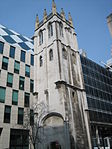Worshipful Company of Pewterers
14th-century establishments in EnglandAll accuracy disputesCharities based in LondonCompanies of medieval EnglandCorporatism ... and 4 more
History of the City of LondonLivery companiesLondon stubsPhilanthropic organization stubs

The Worshipful Company of Pewterers is one of the 110 Livery Companies of the City of London. It ranks 16th in the order of precedence of City Livery Companies and has existed since at least 1348. Like all the other City Livery Companies, the Worshipful Company of Pewterers has four main pillars of activity: Charitable endeavour, assistance to education, support for its trade and profession, and being a convivial and caring social community. The Company has been based at Pewterers' Hall, Oat Lane, near London Wall, since 1961. It is its third livery hall, the first having been destroyed in the Great Fire of London and the second, also by fire, in 1840.
Excerpt from the Wikipedia article Worshipful Company of Pewterers (License: CC BY-SA 3.0, Authors, Images).Worshipful Company of Pewterers
Oat Lane, City of London
Geographical coordinates (GPS) Address Nearby Places Show on map
Geographical coordinates (GPS)
| Latitude | Longitude |
|---|---|
| N 51.51672 ° | E -0.09511 ° |
Address
Pewterers' Hall
Oat Lane
EC2V 7DE City of London
England, United Kingdom
Open on Google Maps








